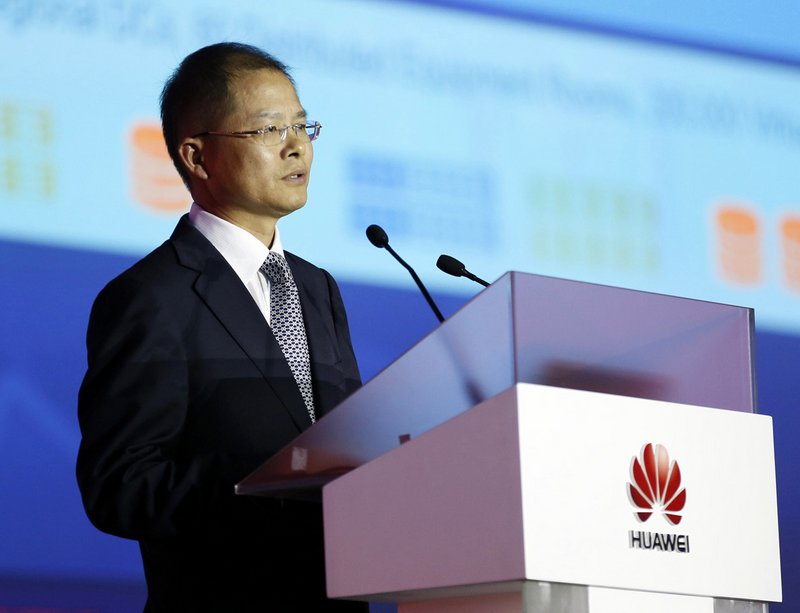Huawei Builds on Cloud-Centric IT Strategy at Huawei Cloud Congress
Launches future-oriented SD-DC² architecture, innovative cloud OS and converged storage system
Shanghai, China, Sept. 16, 2014, –Huawei today underscored its ambition to maximize value for customers by simplifying IT systems and making businesses agile with more open, converged, and innovative technologies, at the Huawei Cloud Congress (HCC) 2014. At the annual event, Huawei will launch a series of innovative IT solutions – including data centers, converged storage, cloud operating systems (OS) and Big Data analytics platforms – that bring to life Huawei’s vision to “Make IT Simple, Make Business Agile.”

Eric Xu, Rotating CEO of Huawei, speaking at Huawei Cloud Congress 2014
HCC gathers over 10,000 customers, partners and industry professionals from more than 80 countries and regions around the world to share insights and promote dialogue on industry trends and topics around cloud computing and Big Data. Participants at the two-day event will hear from 66 of Huawei’s partners and industry leaders across the ecosystem, including Intel, Seagate and SAP.
“Huawei aims to become an IT vendor recognized by enterprises and telecom operators for our innovative, differentiated and industry-leading products and solutions,” said Eric Xu, Rotating CEO of Huawei. “The products and solutions that Huawei is showcasing at HCC this year are all based on our commitment to provide customers with open, converged and innovative technologies that enable them to simplify their traditional IT infrastructure, improve business agility and create greater value.”
One of the flagship solutions to be unveiled at HCC 2014 is Huawei’s future-oriented Service Driven-Distributed Cloud Data Center (SD-DC²). Embodying innovations in cloud, Big Data and data management, this new generation data center helps enterprises build service-driven IT infrastructure that features key capabilities such as service awareness, business intelligence and unified management. In addition, SD-DC² is open and interoperable with products from third-party vendors, enabling customers to better cope with the fast-changing and dynamic IT environment and to accelerate innovation.
In his keynote speech, Zheng Yelai, President of Huawei’s IT Product Line, said, “Rapid developments in the digital world are redefining information technology. We will see increasing mobility-based data consumption, Internet of Things (IoT)-based data collection, Big Data-based data analytics, and cloud-based data sharing in the near future. Enterprise IT consumption models are also changing: the equipment-centric model is evolving into one that centers on applications and services, and independent data management and operation and maintenance (O&M) will evolve into unified management and operations. Future-proof enterprise data centers will need to be service-driven.”
SD-DC² enables efficient operation and management of both traditional and new services, as well as allows more flexible sharing and allocation of IT resources through service awareness, and ultimately supports customers in making business transformation and innovation more agile.
Huawei is also launching the FusionSphere 5.0 open cloud platform and the OceanStor converged storage system, both of which are key components of the SD-DC² architecture.
Huawei FusionSphere 5.0 cloud OS is based on OpenStack architecture and delivers more comprehensive software-defined data center capabilities and boosts management automation capabilities. It also supports the application of cloud-based carrier services and Network Functions Virtualization (NFV). Through standard OpenStack architecture and application programming interfaces (APIs), enterprises have the flexibility to select third-party OpenStack-based cloud products and services, and effectively resolve the vendor lock-in challenge, which limits the breadth of cloud services and products or solution providers that a customer can use.
Designed for enterprise and carrier customers, Huawei’s FusionSphere cloud OS helps customers deploy server virtualization, private cloud, public cloud, and hybrid cloud services on demand. Since its launch, Huawei has built more than 120 cloud data centers based on the FusionSphere cloud OS in 42 countries and regions for customers across industries – including public sector, telecom, energy, finance, transportation, healthcare, education, media, and manufacturing – supporting the integration and optimization of existing data centers and service platforms, and enhancing service system reliability and IT operating efficiency.
Huawei OceanStor is the industry’s first converged storage system and features five key convergence capabilities. First, by converging SAN and NAS, OceanStor reduces investment costs by more than 15% and improves space utilization by 50% over traditional systems. OceanStor also supports the convergence of equipment from multiple vendors, achieving smooth data migration, and enabling customers to boost utilization and protect their existing storage asset. In addition, the system’s converged performance and capacity make it possible to quickly adapt to service needs, switching nimbly between SSD and HDD to achieve the ideal balance between performance and capacity. The convergence of high-end to entry-level storage enables efficient data flow through different data storage levels according to its value to maximize the value of that data, and reduces the cost of utilization by 60%. Lastly, with a converged data lifecycle, where primary storage and backup storage is integrated, customers do not need to purchase dedicated backup software and backup servers, and can achieve data backup within second-level.
As part of its commitment to meeting customer needs in the storage domain, Huawei continuously innovates by leveraging its core technologies and expertise. In particular, the development of Huawei’s storage products has been guided by the approach of “Intelligence on Demand, Convergence for the Future.”
“Software-defined storage is a buzzword in the industry today. While this is an important concept, Huawei places greater emphasis on service-driven storage because we believe the design and evolution of storage architectures must be driven by the needs of customers. We view software-defined solutions as a means to achieving the ultimate goal of maximizing data value based on business needs,” said Fan Ruiqi, President of Huawei’s Storage Product Line. “To this end, Huawei’s OceanStor converged storage system enables efficient data flow to help enterprises generate higher value from data and achieve greater business success.”